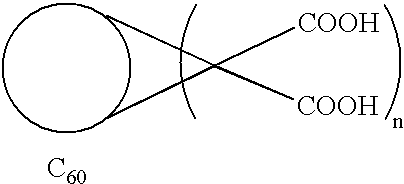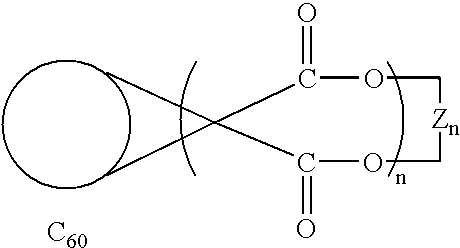Method of synthesis of water soluble fullerene polyacids using a macrocyclic malonate reactant
a macrocyclic malonate and reactionant technology, applied in the field of methods for producing water soluble fullerene polyacids, can solve the problems of unsuitable large-scale production of reaction, low yield of trisadducts, difficult large-scale synthesis of c3, etc., and achieve the effect of improving the yield of specific fullerene isomers and avoiding the production of multiple undesireable addition isomers
- Summary
- Abstract
- Description
- Claims
- Application Information
AI Technical Summary
Benefits of technology
Problems solved by technology
Method used
Image
Examples
Embodiment Construction
Synthesis of the Macrocycle of FIG. 7B
The following reaction was carried out: ##STR22##
In a dry 2L round bottomed flask equipped with gas inlet, 500 ml dropping funnel and magnetic stirrer, 2.00 g (13.7 mmol / 1.00 eq.) octanediol were dissolved under argon in 1L of dry dichloromethane. To this solution 2.16 g (27.3 mmol / 2.22 ml / 2.00 eq.) pyridine were added. Subsequently, a solution of 3.85 g (27.3 mmol / 2 ml / 2.00 eq.) malonyl dichloride in 500 ml of dry dichloromethane was added dropwise over a period of 8 hours. After stirring for two days at room temperature the mixture was concentrated with a rotary evaporator and filtered over a silica plug (6.times.6 cm) with CH.sub.2 CL.sub.2 / ETOAc 90:10 to remove polymeric material and pyridine salts. The solution was evaporated and the resulting slightly yellow crude product was separated by flash chromatography on silica gel (6.times.35 cm / CH.sub.2 CL.sub.2 / EtOAc 90:10). The order of elution of the compounds is 7A, 7B, 7C and 7D. The produ...
PUM
| Property | Measurement | Unit |
|---|---|---|
| Water solubility | aaaaa | aaaaa |
Abstract
Description
Claims
Application Information
 Login to View More
Login to View More - R&D
- Intellectual Property
- Life Sciences
- Materials
- Tech Scout
- Unparalleled Data Quality
- Higher Quality Content
- 60% Fewer Hallucinations
Browse by: Latest US Patents, China's latest patents, Technical Efficacy Thesaurus, Application Domain, Technology Topic, Popular Technical Reports.
© 2025 PatSnap. All rights reserved.Legal|Privacy policy|Modern Slavery Act Transparency Statement|Sitemap|About US| Contact US: help@patsnap.com



